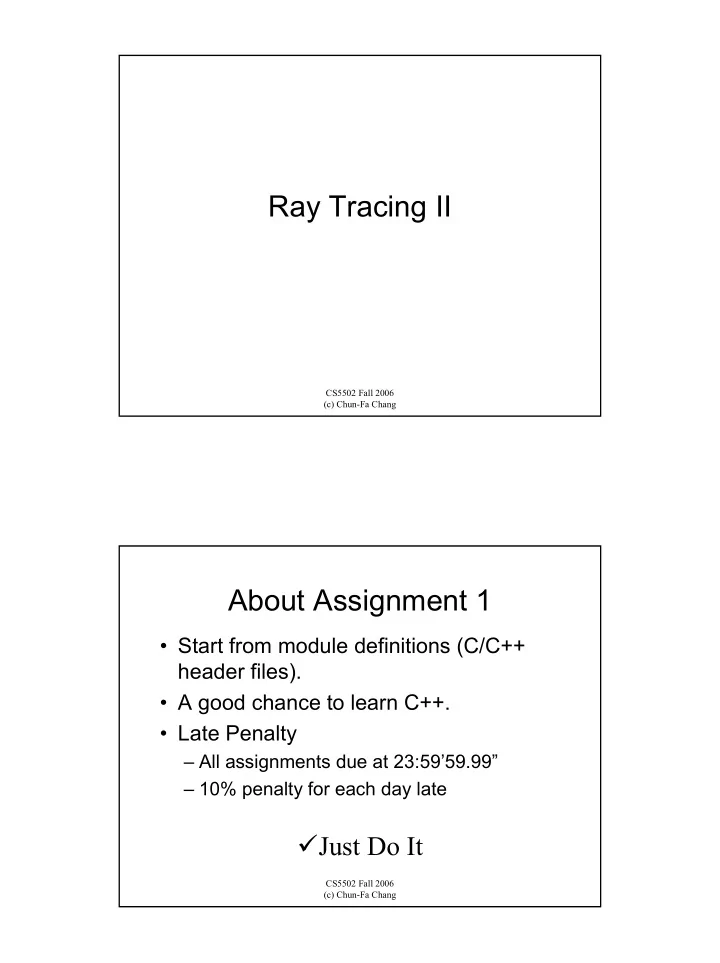

Ray Tracing II CS5502 Fall 2006 (c) Chun-Fa Chang About Assignment 1 • Start from module definitions (C/C++ header files). • A good chance to learn C++. • Late Penalty – All assignments due at 23:59’59.99” – 10% penalty for each day late ! Just Do It CS5502 Fall 2006 (c) Chun-Fa Chang
Advanced Ray Tracing • Make it fast. • Make it better. – Anti-aliasing – Distributed Ray Tracing CS5502 Fall 2006 (c) Chun-Fa Chang Make It Fast • From Pharr’s Chapter 4 – Object subdivision (i.e., bounding volume) – Spatial subdivision (e.g., grid, octree, kd- tree) – Ray coherence. CS5502 Fall 2006 (c) Chun-Fa Chang
Anti-Aliasing • Super(or Over)-sampling • Adaptive vs. Non-adaptive • Uniform vs. Jittered • Detail coming in a future lecture CS5502 Fall 2006 (c) Chun-Fa Chang Distributed Ray Tracing • Published by R. L. Cook in 1984. • Antialiasing • Motion blur • Depth of field (camera) • Ideas behind other so-called Monte Carlo methods. CS5502 Fall 2006 (c) Chun-Fa Chang
Space Partitions CS5502 Fall 2006 (c) Chun-Fa Chang Common Operations in 3D • Line/object intersection – Given a ray or line, which object will it intersect? • View frustum culling • Collision detection CS5502 Fall 2006 (c) Chun-Fa Chang
Sorting/Indexing in 3D • Sequential search is too slow for large models. • How about storing them in a 3D array? – Size will be overwhelming • Think “hierarchy” CS5502 Fall 2006 (c) Chun-Fa Chang Octree • Divide the space in halves in X/Y/Z. – Always split in the middle. – You may also consider them as splitting in X, then in Y, then in Z. • If too many objects are in a partition, divide them again (recursively). CS5502 Fall 2006 (c) Chun-Fa Chang
K-D Tree • More flexible than octree: – Not always splitted in the middle. – Split in X, then in Y, then in Z, or any order. CS5502 Fall 2006 (c) Chun-Fa Chang Kd-tree Example 4 6 1 10 8 2 3 11 3 13 2 4 5 6 7 12 8 9 10 11 12 13 9 Figure Source: CS638 slides by Stephen Chenney, University of Wisconsin – Madison, 5 1 7 CS5502 Fall 2006 (c) Chun-Fa Chang
BSP Trees • From the paper by Fuchs et al, “On visible surface generation by a priori tree structures” SIGGRAPH 80. • Binary Space Partition trees – A sequence of cuts that divide a region of space into two • Cutting planes can be of any orientation CS5502 Fall 2006 (c) Chun-Fa Chang Drawing Order from BSP Trees • BSP tress can be used to order polygons from back to front, or visa-versa – Descend tree with viewpoint – Things on the same side of a splitting plane as the viewpoint are always in front of things on the far side • Can draw from back to front – Gives the correct order for rendering transparent objects with a z-buffer, and by far the best way to do it • Can draw front to back too. CS5502 Fall 2006 (c) Chun-Fa Chang
BSP Example 1 1 2 2 4 A 3 out 5 7 3 A out B 6 8 out 6 5 B C C out D out D Figure Source: CS638 slides by Stephen Chenney, University of Wisconsin – Madison, 4 8 7 CS5502 Fall 2006 (c) Chun-Fa Chang OBB Tree • OBB stands for Oriented Bounding Box. • OBB is a rectangular bounding box at an arbitrary orientation. • Asymptotically faster for close proximity situations. CS5502 Fall 2006 (c) Chun-Fa Chang
Recommend
More recommend